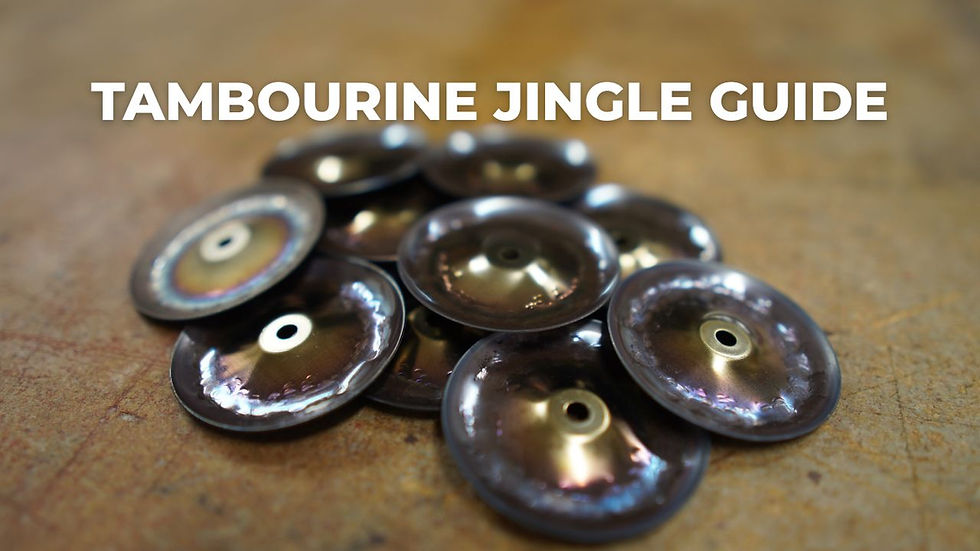Tambourine Jingle Guide: Choosing the Right Sound
- Nathan Coles
- May 22
- 4 min read
How metal type shapes tone color—and your musical phrasing

For orchestral percussionists, the tambourine can be a surprisingly nuanced instrument. You don’t just need technique—you need taste. And one of the biggest tonal choices you’ll make? Your jingles.
Black Swamp Percussion offers six distinct jingle types, and each one creates a signature tone that can enhance or clash with the color of the ensemble. If you’ve ever wondered why one tambourine sounds glassy and another rich and dark, you’re not alone. In this post, we’ll break down what each jingle alloy offers, how to listen for the right character, and how professional players approach their setup like a painter choosing brushes.
Table of Contents
Don’t miss a post—sign up for the Black Swamp Newsletter for exclusive insights, artist interviews, and sound demos that help you make musical decisions with confidence.
What Makes Tambourine Jingles Sound Different?

Jingle sound is shaped by metal type, thickness, shape, hammering, and finish—but the alloy is the biggest factor. Alloys determine the overtone series, response time, shimmer, and articulation. In a concert hall, that means certain metals will cut like crystal, while others nestle into the orchestral texture with warmth and blend.
Black Swamp Founder and President, Eric Sooy, remarks about a conversation with Percussionist Chris Lamb about tambourine jingles. "They're like little cymbals..." Chris explained. Shaping and hammering the jingles to create complex tones is essential to a quality jingle sound. Each Black Swamp jingle has a unique hammering pattern that differs from the rest of the jingles. This allows each jingle to have a slightly different pitch and overtone series, resulting in a much fuller and richer tone from your tambourine.
Similar to cymbals, the longer a set of tambourine jingles is "played in" the more lively they can become. Eric reflected upon some of his first tambourine builds; "Those early Black Swamp tambourines sound really good." After years of use and allowing the alloys to "settle", the jingles have a mature timbre of a quality instrument.
What sounds “better” isn’t universal. It’s about matching tone color to the music, the ensemble, and the hall.
Meet the Metals: The 6 Jingle Types
Let’s break down each jingle option offered by Black Swamp:
Alloy | Tone Character | Tactile Response |
Bright, articulate, crunchy | Crisp, quick attack. Becomes more articulate over time. | |
Dark, full-bodied, warm shimmer | Moderate sustain becomes more mellow as the jingles are "played in" | |
A traditional tambourine sound. Bright and full with a wet, sonorous blend. | Clean response, long sustain. | |
Rich, complex, sparkly overtones | Fast yet resonant | |
Dark, mellow, earthy | Slower decay, soft presence | |
Warm, bright, with a round tone. | Balanced attack and sustain |
Customizing Timbre: Shaping Sound with What You Already Own
Let’s say you don’t have a shelf full of tambourines in every alloy—yet. The good news is: you can still explore a surprising range of tone with a few physical modifications and techniques using the tambourine you already own.
Here are some ways professional percussionists change timbre on the fly—or in preparation for a specific piece.
Jingle Control
Crimping Jingles: Lightly pinching jingles with pliers flattens the curvature, reducing sustain and brightness. This results in a drier, more immediate response. Many players crimp only some of the jingles for a hybrid sound.
Jingle Mutes: You can tape thin felt or moleskin between jingles to reduce ring. Some players insert small pieces of foam to “quiet” specific jingles without fully muting them.
Black Swamp Artist, Josh Jones, has a great comparison of two identical tambourines. One model is a brand new TC1S (Chromium/Bronze jingles with a Remo Synthetic head). The other is a TC1 (Chromium/Bronze jingles with a calf-skin head) but features crimped jingles. Take a listen to the contrasting tones between these two tambourines.
Black Swamp Artist, Keith Aleo, also gives a demonstration of the tonal differences between tambourines without crimped jingles, with a few crimped jingles, and all crimped jingles.
Tip: If you’re experimenting with jingle crimping, do so carefully—and ideally not on your most expensive tambourine first. Test the effect on an older or secondary instrument.
Head Damping
Felt/Tape on the Head: Applying moleskin or gaffer tape to the bottom of the tambourine head reduces resonance and creates a drier attack. This drys out the head tone of the instrument while giving the jingles more room to fill the sound.
Grip & Playing Position
Flat Hold vs. Vertical: Holding the tambourine flat (parallel to the floor) reduces that resonance by allowing jingles to settle more quickly. Tilting it vertically often increases jingle sustain.
Use these positions to create more or less sustain with your tambourine for specific passages.
Musical control doesn’t require endless gear—it comes from understanding how to shape sound with intention.
Final Thoughts: Tone is a Decision
The best percussionists make musical choices at every level—even down to the metal alloy of a tambourine jingle. It’s not about collecting gear. It’s about having the right color ready for the right moment.
You don’t need every tambourine under the sun. But you do need to know what each one gives you—and how to listen.
So the next time you reach for a tambourine, ask yourself: What do I want this moment to sound like?
















Comments